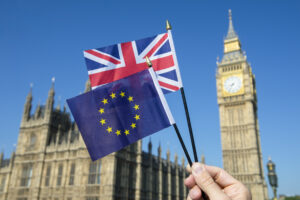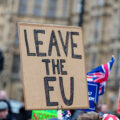Is the Brexit movement a religion? Part 4: The practices of Brexiteers
Is the Brexit movement a religion? Part 4: The practices of Brexiteers
Our analyst Frazer MacDiarmid looks at the practices and performances of Brexit believers. How do these compare to the practices within religions? A look at the Brexit leadership reveals some striking parallels with church hierarchy.
This article was written by Frazer MacDiarmid and reflects his personal analyses and opinions, rather than those of EARS.
Previous articles in this mini-series on the religion of Brexit have already assessed the first two of sociologist Ronald L. Johnstone’s five characteristics of a religion – namely, that religion occurs in a communal context, and involves a body of beliefs. Here, we turn to look at his third: that a religion revolves around a ‘set of practices’. I paraphrase Johnstone’s definition here:
A religion is usually based around ritual or ritualistic practices, in which adherents most clearly act out a set of “normative expectations.” Since this involves visible actions, the performance of ritual and other behaviours associated with a religion’s beliefs is a particularly obvious characteristic.[1]
The performance of Brexit
One striking feature of the Brexit movement was its visibility. From my personal experience, during the height of the campaign it was difficult not to notice the Vote Leave stalls stationed on high streets across the country. Spokespeople stopped shoppers and workers to talk about the coming demise of Britain under the EU and how a vote for Leave is a vote for the NHS (National Health Service). Stationed alongside fundamentalist Christian doom mongers, Muslims for Peace giving away Qurans, and Jehovah’s Witnesses with more pamphlets than a doctor’s waiting room, the Vote Leave prophets spread their emotionally-charged[2] message to anyone who would listen.
This visibility was an essential part of Vote Leave’s strategy, and key to its ultimate success. Vote Leave leadership made all campaign materials open source, and encouraged followers to “download, print and buy campaign posters, leaflets and other materials,” and distribute them “to show your support and inform the public” about the campaign’s message.[3] An eager follower can show their support with posters and leaflets in a variety of striking colours and designs, or “dress” their social media profiles with authorised logos. The webpage helpfully suggests “where to use” each one, including while “canvassing,” at “rallies,” in “street stalls,” on “flyers,” “posters,” “banners,” or to put in “windows.”[4] The Brexit community actively participated in practices of spreading the good news of Brexit. To draw from a religious term, this might be called ‘Brexit evangelisation’. Indeed, campaign leaders clearly depended upon the persuasiveness of ordinary Brits investing their own time and money to support Brexit.
A matter of identity
Brexiteers did not stop at distributing leaflets and talking to strangers. Adherents transformed themselves into living, breathing, walking promotions for Brexit. Vote Leave badges emblazoned the shirts and jackets of supporters.[5] The more ardent among them wore Vote Leave t-shirts and other merchandise,[6] some even getting tattoos[7] [8] – a show of support rather tricky to change one’s mind about. Other campaigners considered the risk of ridicule worth taking for the sake of Brexit and covered themselves in Vote Leave paraphernalia while brandishing “Believe in Britain” posters.[9]
We saw in a previous article that whether one believed in Leave or Remain was often closely connected to one’s personal identity, just as one’s religion is a key identity marker. The branding of one’s own body with Vote Leave iconography and performing associated practices visibly demonstrate how Brexit became a part of people’s personal and collective identity.
Participating in a rally or mass protest was another particularly powerful practice, activating the strong emotions and instincts experienced by members of large gatherings.[10] Pro-Brexit demonstrators regularly joined together in songs denigrating the European Union; the practice of singing is central in many religions, and is often noted for its effect of uniting participants.[11]
It is worth noting that, just as it would be difficult to identify a single practice as absolutely essential for membership in a religious group, so too with the practices surrounding Brexit. Clearly some more inspired believers took part in many pro-Brexit practices, whereas others chose to take part in none.
The single practice that by definition marked out a believer in Brexit was turning up to vote on 23 June 2016 (referendum day) and ticking LEAVE on the ballot sheet.
How can we explain all this?
Adherents to a religious movement demonstrate their religious commitment by the performance of certain normative practices defined by the movement’s authorities. Let us take the example of the Roman Catholic Church. Practices of its adherents might include: eating bread and wine understood to be the body and blood of Christ, abstaining from eating certain foods on holy days, or evangelism – actively spreading the gospel message of Christ’s resurrection and salvation through him. All of these practices are prescribed by the founding texts of Christianity and have been confirmed as good and worthy by church leadership throughout history.[12] Catholic Christians can recognise each other by the fact that they are performing the same practices. From a sociological perspective, we might say that leaders promote these practices in order to create a culture of obedience and normativity within the church, and to reinforce the hierarchy that separates leaders from followers.[13]
In the same way, those who believe in Brexit act out their commitment by performing practices like canvassing on street corners, inscribing Vote Leave iconography on their bodies and clothes, or by singing and chanting in large groups. We have seen how many of these practices were explicitly authorised and encouraged by the Leave campaign, and its various anti-EU narratives.
It might be said, too, that the leaders of the Brexit movement hoped to secure a mandate for their own authority if those who practised Brexit became great enough in number.
With Boris Johnson now in the office of Prime Minister, it appears their strategy was successful.
This article was written by Frazer MacDiarmid and reflects his personal analyses and opinions, rather than those of EARS.
Our team of analysts conducts daily research on religion and society. In the past month, the topics of tension, leadership, and image were trending. Find out their relationships on the EARS Dashboard.
[1] Ronald L. Johnstone, Religion in Society: A Sociology of Religion (Routledge, 2015), pp. 8-14
[2] It is a widely-held opinion in scholarship that the Leave campaign did a better job than the Remain campaign at appealing to the emotions and imaginations of voters. See, e.g., Marsh, D., ‘Brexit and the Politics of Truth,’ British Politics 13.1 (2018), 79–89.
[3] Vote Leave: Campaign Resources
[4] Vote Leave: Campaign Resources
[5] Brexit: Dominic Cummings urges Vote Leave activists to form party
[6] Vote Leave drops appeal against fine for electoral offences
[7] People Are Getting Tattoos To Mark The EU Referendum
[8] Brexit fan gets October 31 exit date tattooed on his stomach
[9] Parliament Comes Down To The Wire On Brexit Deal, May Vote To Extend Deadline
[10] Making Sense of the ‘Mob’ Mentality
[11] MacDiarmid, F., ‘De Utilitate Cantorum: Unitive Aspects of Singing in Early Christian Thought,’ Anglican Theological Review 100.2 (2018), pp. 291-309.
[12] Luke 22:19; 1 Cor. 11:24-25. 1 Cor. 7:5; Matt. 6:16-18. Matt. 28:19-20.
[13] Castelli, E. Imitating Paul: A Discourse of Power (Louisville, KY: Westminster/John Knox Press, 1991).






